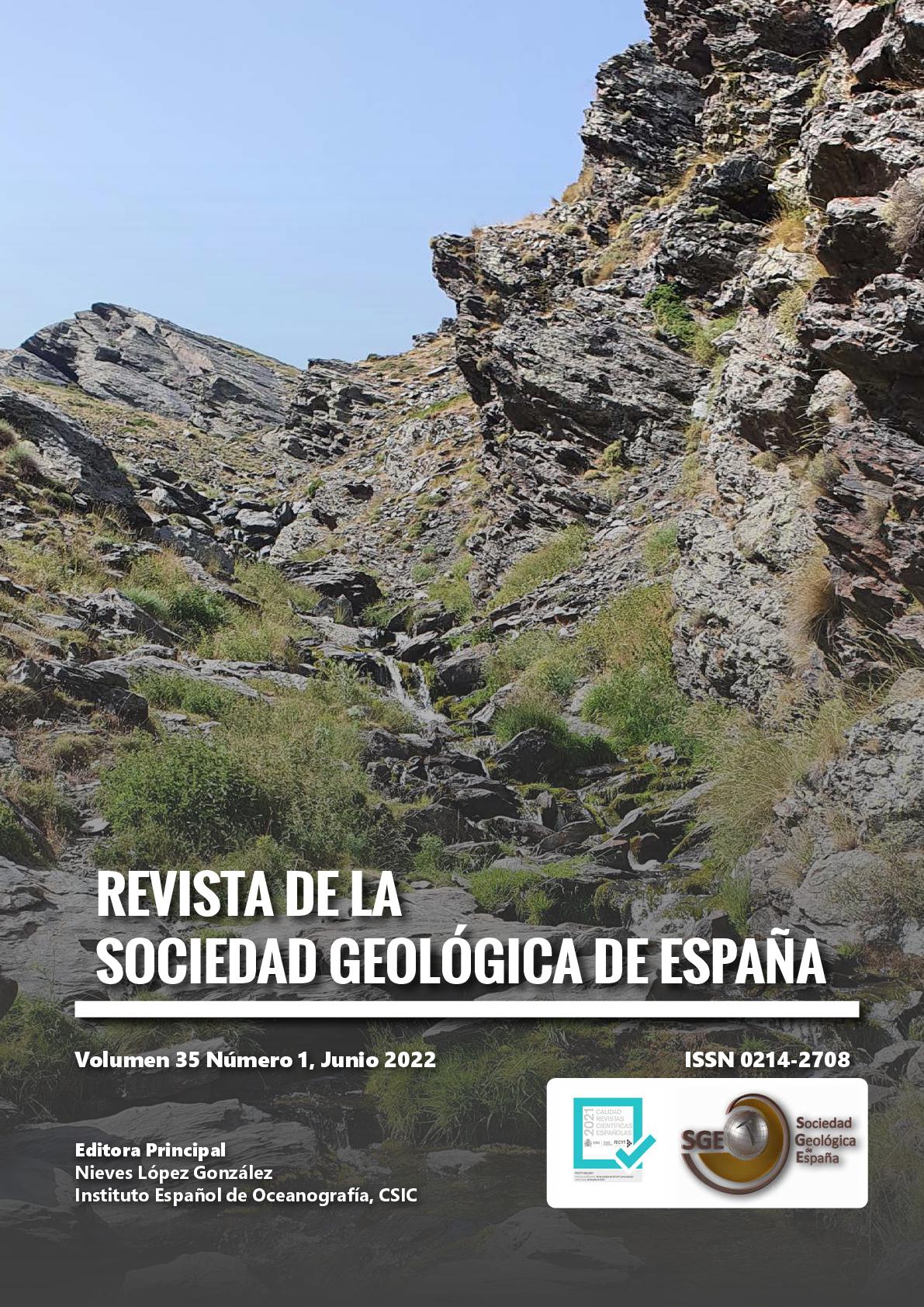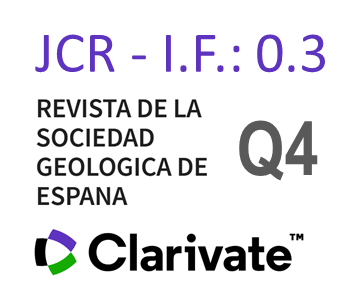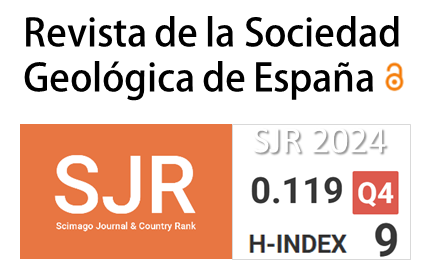Transferencias arenosas transversales y longitudinales entre playas apoyadas y dunas asociadas en la costa de Asturias (NO de la península Ibérica)
DOI:
https://doi.org/10.55407/rsge.94880Palabras clave:
playas apoyadas, dunas, arenas, bioclastos, transporte sedimentarioResumen
En las playas arenosas apoyadas de la costa acantilada de Asturias (NO de España, Península Ibérica), los componentes arenosos siliciclásticos derivan principalmente de aportaciones fluviales, mientras que los carbonatos (bioclastos) provienen de organismos de la franja rocosa perimareal, algunos heredados. Se estudian las características sedimentológicas de estas playas en un amplio segmento de 387 km de costa. A partir de los parámetros de rango (centil más grueso) y de relación, así como de la composición (tasa de sílice/carbonato biogénico), se deducen las transferencias transversales entre playa y dunas eólicas asociadas, y la distribución longitudinal, sectorizando diferentes tramos costeros. En general, desde la playa hasta el campo dunar eólico, el tamaño medio de grano disminuye, el calibrado mejora y el porcentaje de carbonato biogénico disminuye; y, desde una playa apoyada a la adyacente, lo que confirma una corriente de deriva costera O-E. Las descargas siliciclásticas fluviales se homogenizan con los carbonatos bioclásticos desde los ámbitos estuarinos cuyos máximos se relacionan con afloramientos oceanográficos regionales y locales. Esto último ocurre al chocar la corriente costera contra algún gran promontorio o, más habitualmente, si los nutrientes procedentes de grandes estuarios con llanuras fangosas y marismas bien desarrollados incrementan la proporción de los organismos perimareales.
Citas
Albino, J., Suguio, K., 2011. The influence of sediment grain size and composition on the morphodynamic state of mixed siliciclastic and bioclastic sand beaches in Espirito Santo State, Brazil. Revista Brasileira de Geomorfologia, 12: 81-92. https://doi.org/10.20502/rbg.v12i2.237
Álvarez García, M.A., de Castro, M., Cruz Guerrero, R., Gómez Borrego, Á., Pérez Muñuzuri, V. Stöll, H., 2009. Clima. Evidencias y efectos potenciales del cambio climático en Asturias. Consejería de Medio Ambiente, Ordenación del Territorio e Infraestructuras. Gobierno del Principado de Asturias, 30-65.
Anderson, R.S., Sørensen, M., Willetts, B.B., 1991. A review of recent progress in our understanding of aeolian sediment transport. Acta Mechanica (Suppl), 1: 1-19. https://doi.org/10.1007/978-3-7091-6706-9_1
Anthony, E.J., 2015. Environmental Control: Geology and Sediments. En: G. Masselink, R. Gehrels (Eds). Coastal Environments & Global Change, J. Wiley & Sons, 52-78. https://doi.org/10.1002/9781119117261.ch3
Aranda, M., Gracia, J., Peralta, G., Flor-Blanco, G. 2020. The application of high-resolution mapping for the analysis of recent eco-geomorphological changes in the saltmarshes of San Vicente de la Barquera estuary (North Spain. Journal of Coastal Research, SI, 95: 341-345. https://doi.org/10.2112/SI95-066.1
Arens, S.M., van Boxel, J.H., Abuodha, J.O.Z., 2002. Changes in grain size of sand transport over a foredune. Earth Surface Processes and Landforms, 27: 1163-1175. https://doi.org/10.1002/esp.418
Atlas Climático Ibérico, 2011. Temperatura del aire y precipitación (1971-2000). Agencia Estatal de Meteorología. 79 p.
Bagnold, R.A., 1941. The physics of blown sand and desert dunes. Methuen, London. 265 p.
Barsanti, M., Calda, N., Valloni, R., 2011. The Italian coasts: a natural laboratory for the quality evaluation of beach replenishments. Journal of Coastal Research, SI, 61: 1-7. https://doi.org/10.2112/SI61-001.1
Blott, S.J., Pye, K., 2001. GRADISTAT: a grain size distribution and statistics package for the analysis of unconsolidated sediments. Earth Surface Processes and Landforms, 26: 1237-1248. https://doi.org/10.1002/esp.261
Carter, R.W.G., 1988. Coastal environments: An introduction to the physical, ecological and cultural systems of coastlines. Academic Press Ltd. London. 617 p.
Cendrero, A., Sánchez-Arcilla, A., Zazo, C., 2005. Impacts on coastal areas. En: J.M. Moreno (Ed). Impacts of the climatic change in Spain. Ministerio de Medio Ambiente. Madrid, 451-504.
Chust, G., Borja, Á., Liria, P., Galparsoro, I., Marcos, M., Caballero, A., Castro, R., 2009. Human impacts overwhelm the effects of sea-level rise on Basque coastal hábitats (N Spain) between 1954 and 2004. Estuarine, Coastal and Shelf Science, 84: 453-462. https://doi.org/10.1016/j.ecss.2009.07.010
Chust, G., Caballero, A., Marcos, M., Liria, P., Hernández, C., Borja, Á., 2010. Regional scenarios of sea level rise and impacts on Basque (Bay of Biscay) coastal habitats, throughout the 21st century. Estuarine, Coastal and Shelf Science, 87: 113-124. https://doi.org/10.1016/j.ecss.2009.12.021
Daly, C.J., Winter, C., Bryant, K.R., 2015. On the morphological development of embayed beaches. Geomorphology, 248: 252-263. https://doi.org/10.1016/j.geomorph.2015.07.040
Darryl, L.F., Textoris, D.A., 1972. Size, grain type and mineralogical relationships in recent marine calcareous beach sands. Sedimentary Geology, 7: 89-102. https://doi.org/10.1016/0037-0738(72)90030-9
Davidson-Arnot, R., 2010. Introduction to Coastal Processes and Geomorphology. Cambridge University Press. 442 p.
Dehouck, A., Dupuis, H., Sénéchal, N., 2009. Pocket beach hydrodynamics: The example of four macrotidal beaches, Brittany, France. Marine Geology, 266: 1-17. https://doi.org/10.1016/j.margeo.2009.07.008
Fernández-Valdés, J.M., 1997. Morfología y sedimentación de la plataforma continental interna del área central de Asturias. Tesis Doctoral (inédita). Departamento de Construcción e Ingeniería de la Fabricación. Universidad de Oviedo. 322 p.
Fernández-Valdés, J.M., Flor, G., Viña, C., 1994. The bioclastic component of the inner shelf surficial sediments in the Asturian central area (NW Spain, Bay of Biscay). Gaia, Revista de Geociências, 8: 135-141.
Ferre, B., Sherwood, C.R., Wiber, P., 2010. Sediment transport on the Palos Verdes shelf, California. Continental Shelf Research, 30: 761-780. https://doi.org/10.1016/j.csr.2010.01.011
Figueiras, F.G., Labarta, U., Fernández Reiriz, M.J., 2002. Coastal upwelling, primary production and mussel growth in the Rías Baixas of Galicia. Hydrobiologia, 484: 121-131. https://doi.org/10.1007/978-94-017-3190-4_11
Flor, G., 1978. Relación entre la distribución de sedimentos y la circulación costera en la región del Cabo Peñas. Trabajos de Geología, 10: 183-194.
Flor, G., 1979. Depósitos arenosos de las playas de la región de Cabo Peñas: sedimentología y dinámica. Tesis Doctoral (inédita). Departamento de Estratigrafía. Universidad de Oviedo. 514 p.
Flor, G., 1980. Los carbonatos biogénicos del área intermareal de playa en relación con la geografía y dinámica costeras. Boletín Real Sociedad Española de Historia Natural (Geología), 78: 275-289.
Flor, G., 1981. Los parámetros texturales en las playas y dunas arenosas del borde occidental del Cabo Peñas (Xagó y Verdicio, Asturias). Boletín de la Real Sociedad. Española de Historia Natural (Geología), 79: 89-102.
Flor, G., 1990. Tipología de dunas eólicas. Procesos de erosión-sedimentación costera y evolución litoral de la provincia de Huelva (Golfo de Cádiz occidental, Sur de España). Estudios Geológicos, 46: 99-109. https://doi.org/10.3989/egeol.90461-2442
Flor, G., 2004. Geología Marina. Servitec. Oviedo. 654 p.
Flor, G., Flor-Blanco, G., 2005. An introduction to the erosion and sedimentation problems in the coastal regions of Asturias and Cantabria (NW Spain) and its implications on environmental management. Journal of Coastal Research, SI 49: 58-63.
Flor, G., Flor Blanco, G., 2009. Sedimentología de los depósitos arenosos superficiales de la playa de Vega (Concejo de Ribadesella, Asturias). Revista de la Sociedad Geológica de España, 22 (1-2): 105-121.
Flor, G., Flor-Blanco, G., 2013. Geomorfología del litoral oriental de Asturias. VII Jornadas de Geomorfología Litoral. Guía de Campo. 40 p. Oviedo.
Flor, G., Flor-Blanco, G., 2014a. Raised beaches in the Cantabrian Coast. En: F. Gutiérrez, M. Gutiérrez Elorza (Eds). Landscapes and Landforms in Spain. World Geomorphological Landscapes, 239-248. Springer Science+Business Media Dordrecht. https://doi.org/10.1007/978-94-017-8628-7_20
Flor, G., Flor-Blanco, G., 2014b. Componentes de viento generadores de morfologías y campos de dunas costeras en Asturias (NO de España). Cuaternario y Geomorfología, 28 (3-4): 47-68.
Flor, G., Llera, E.M., Ortea, J.Á., 1982. Los carbonatos biogénicos de los sedimentos de las playas arenosas de Asturias y Cantabria: su origen y significado dinámico. Cuadernos del CRINAS, 2, 77 p.
Flor, G., Martínez Cedrún, P., Flor-Blanco, G., 2011. Campos dunares de Asturias, Cantabria y País Vasco. En: E. Sanjaume, F.J. Gracia (Eds). Las dunas en España, 127-159. Sociedad Española de Geomorfología.
Flor, G., Cabrera Ceñal, R., Suárez González, M.A., Iglesias Ortega, P. J., 1990. Contaminación sólida en el estuario del Nalón (Asturias). IV Reunión Nacional de Geología Ambiental y Ordenación del Territorio, Comunicaciones, 165-180. Universidad de Oviedo. Gijón.
Flor, G., Flor-Blanco, G., Cedrún, P. M., Flores-Soriano, C., Borghero, C. 2019. Aeolian dune fields in the coasts of Asturias and Cantabria (Spain, NW Iberian Peninsula). En: The Spanish Coastal Systems. Springer, Cham, 585-609. https://doi.org/10.1007/978-3-319-93169-2_25
Flor-Blanco, G., Flor, G., 2009. Aspectos geomorfológicos del tramo inferior del estuario de Villaviciosa (Asturias) en relación con su evolución histórica. Revista de la Sociedad Geológica de España, 22: 123-136.
Flor-Blanco, G., Flor, G., 2016. Management of dune fields on the coasts of Asturias, Cantabria and the Basque Country (Cantabrian Sea, NW Iberian Peninsula). En: F.X. Roig-Munar (Ed). Restoration and management of dune systems. Case studies, 35-70. Edition: Càtedra d'Ecosistemes Litorals Mediterranis, Parc Natural del Montgrí, les Illes Medes i el Baix Ter, Museu de la Mediterrània, Publisher: project "Life Pletera" (LIFE13 NAT/ES/001001).
Flor-Blanco, G., Flor, G., 2019. Cantabrian estuaries. En: The Spanish Coastal Systems. Springer, Cham, 415-436. https://doi.org/10.1007/978-3-319-93169-2_18
Flor-Blanco, G., Flor, G., Pando, L., 2013. Evolution of the Salinas-El Espartal and Xagó beach/dune systems in north-western Spain over recent decades: evidence for responses to natural processes and anthropogenic interventions. Geo-Marine Letters, 33: 143-157. https://doi.org/10.1007/s00367-012-0301-3
Flor-Blanco, G., Bruschi, V., Adrados, L., Flor, G., Trenhaile, A.S., Domínguez, M.J., Cendrero, A., Remondo, J., 2015a. Propuesta de un modelo de evolución de costas acantiladas calcáreas: Asturias y Cantabria (N de España). En: G. Malvárez, F., Navas, E. Guisado (Eds). VIII Jornadas de Geomorfología Litoral 2015. Marbella. Geo-Temas, 15: 13-16.
Flor-Blanco, G., Pando, L., Morales, J.A., Flor, G., 2015b. Evolution of beach-dune fields systems following the construction of jetties in estuarine mouths (Cantabrian coast, NW Spain). Environmental Earth Sciences, 73 (3): 1317-1330. https://doi.org/10.1007/s12665-014-3485-1
Flor-Blanco, G., Rubio-Melendi, D., Flor, G., Fernández-Álvarez, J.P., Jackson, D.W.P., 2016. Holocene evolution of the Xagó dune field (Asturias, NW Spain) reconstructed by means of morphological mapping and ground penetrating radar surveys. Geo-Marine Letters, 36: 35-50. https://doi.org/10.1007/s00367-015-0427-1
Flor-Blanco, G., Alcántara-Carrió, J., Jackson, D., Flor, G., Flores-Soriano, C., 2021. Coastal erosion in NW Spain: Recent patterns under extreme storm wave events. Geomorphology, 387: 107767. https://doi.org/10.1016/j.geomorph.2021.107767
Folk, R.L., Ward, W.C., 1957. Brazos River bar: a study in the significance of grain size parameters. Journal Sedimentary Petrology, 27: 3-26. https://doi.org/10.1306/74D70646-2B21-11D7-8648000102C1865D
García, M.J., Tel, E., Molinero, J., 2012. Sea-level variations on the north and northwest coasts of Spain. ICES Journal Marine Science, 69 (5): 720-727. https://doi.org/10.1093/icesjms/fss058
García-Ordiales, E., Flor-Blanco, G., Roqueñí, N., Covelli, D., Cienfuegos, P., Álvarez, R., Fontolan, G., Loredo, J., 2020. Anthropocene footprint in the Nalón estuarine sediments (northern Spain). Marine Geology, 424: 106167. https://doi.org/10.1016/j.margeo.2020.106167
García-Ramos, J.C., Piñuela, L., Lires, J., 2011. Atlas del Jurásico de Asturias. (2ª Ed). Ed. Nobel, Oviedo. 225 p.
Giles, R.T., Pilkey, O.H., 1965. Atlantic beach and dune sediments of the southern United States. Journal Sedimentary Petrology, 35: 900-910. https://doi.org/10.1306/74D7139D-2B21-11D7-8648000102C1865D
Gómez-Pina, G., Muñoz-Pérez, J., Ramírez, J.L., Ley de Vega-Seoane, C., 2002. Sand dune management problems and techniques, Spain. Journal of Coastal Research, SI 36: 325-32. https://doi.org/10.2112/1551-5036-36.sp1.325
Gómez-Pujol, Ll., Roig-Munar, F.X., Fornós, J.J., Balaguer, P., Mateu, J., 2013. Provenance-related characteristics of beach sediments around the island of Menorca, Balearic Islands (western Mediterranean). Geo-Marine Letters, 33: 195-208. https://doi.org/10.1007/s00367-012-0314-y
González, M., Ferrer, M., Uriarte, A., Urtizberea, A., Caballero, A., 2008. Operational oceanography system applied to the Prestige oil-spillage event. Journal Marine Systems, 72: 178-188. https://doi.org/10.1016/j.jmarsys.2007.07.005
Gutiérrez-Claverol, M., Luque, C., Martínez-García, E., Riuz, F., Suárez, V., 1988. Los lineamientos deducidos de imágenes de satélite de las Zonas Cantábrica y Asturoccidental-leonesa (NW de España). Estudios Geológicos, 44: 263-270. https://doi.org/10.3989/egeol.88443-4544
Hill, P.R., Conway, K., Lintern, D.G., Meulé, S., Picard, K., Barrie, J.V., 2008. Sedimentary processes and sediment dispersal in the southern Strait of Georgia, BC, Canada. Marine Environmental Research, 66: S39-S48. https://doi.org/10.1016/j.marenvres.2008.09.003
Hudson, J., Collinson, J., Leeder, M., 1981. Comparison of methods of size analysis for sand of the Amazon-Solimões Rivers, Brasil and Peru. Sedimentology, 28 (1): 123-128. https://doi.org/10.1111/j.1365-3091.1981.tb01669.x
Johnson, M.J., 1993. The system controlling the composition of clastic sediments. En: M.J. Johnson, A. Basu (Eds). Processes controlling the composition of clastic sediments. Geological Society American, Special Paper, 284: 1-19. https://doi.org/10.1130/SPE284-p1
Klein, A.H.F., Benedet Filho, L, Schumacher, D.H., 2002. Short-term beach rotation processes in distinct headland bay beach systems. Journal of Coastal Research, 18 (3): 442-458.
Lavín, A., Moreno-Ventas, X., Ortiz de Zárate, V., Abaunza, P., Cabanas, J. M., 2007. Environmental variability in the North Atlantic and Iberian waters and its influence on horse mackerel (Trachurus trachurus) and albacore (Thunnus alalunga) dynamics. ICES Journal of Marine Science, 64: 425-438. https://doi.org/10.1093/icesjms/fsl042
Llopis Lladó, N., 1962. Estudio geológico de la región de Cabo Peñas (Asturias). Mapa Geológico de Asturias, Hojas nº 1 y 2. Escala 1/25.000. Real Instituto de Estudios Asturianos RIDEA. Oviedo.
López-Fernández, C., Llana-Funez, S., Fernández-Viejo, G., Domínguez-Cuesta, M.J., Díaz-Díaz, L.M., 2020. Comprehensive characterization of elevated coastal platforms in the north Iberian margin: A new template to quantify uplift rates and tectonic patterns. Geomorphology, 364: 107242. https://doi.org/10.1016/j.geomorph.2020.107242
López Peláez, J., 2017. El estuario de Avilés, 1833/2016. Nieva Ediciones. 157 p.
Loureiro, C., Ferreira, Ó., Cooper, J.A.G., 2012. Geologically constrained morphological variability and boundary effects on embayed beaches. Marine Geology, 329: 1-15. https://doi.org/10.1016/j.margeo.2012.09.010
Martins, L.R., 1965. Significance of skewness and kurtosis in environmental interpretation. Journal of Sedimentary Petrology, 35 (3): 768-770. https://doi.org/10.1306/74D7135C-2B21-11D7-8648000102C1865D
Martins, L.R., 2003. Recent sediments and grain-size analysis. Gravel, 1: 90-105.
Martínez Cedrún, P., Flor, G., Flor-Blanco, G., Maroto González, G., 2014. Relaciones texturales y composición mineralógica de los sistemas de playa/dunas en una costa rocosa: caso de Cantabria (NO de España). Revista de la Sociedad Geológica de España, 27(2): 13-27.
Mason, C.L., Folk, R.L., 1958. Differentiation of beach, dune and aeolian flat environments by size analysis, Mustang Island, Texas. Sedimentary Geology, 56: 167-192.
Matias, A., Ferreira, Ó., Mendes, I., Dias, J.A., Vila-Concejo, A., 2005. Artificial construction of dunes in the South of Portugal. Journal of Coastal Research, 21 (3): 472-481. https://doi.org/10.2112/03-0047.1
McLaren, P., Bowles, D., 1985. The effects of sediment transport on grain size distributions. Journal Sedimentary Petrology, 55: 457-470. https://doi.org/10.1306/212F86FC-2B24-11D7-8648000102C1865D
Medellín, G., Medina, R., Falqués, A., González, M., 2008. Coastline sand waves on a low-energy beach at "El Puntal" spit, Spain. Marine Geology, 250: 143-156. https://doi.org/10.1016/j.margeo.2007.11.011
Middleton, G.V., 1976. Hydraulic interpretation of sand size distributions. Journal Geology, 84: 405-426. https://doi.org/10.1086/628208
Mycielska-Dowgiallo, E., Ludwikowska-Kędzia, M., 2011. Alternative interpretations of grain-size data from Quaternary deposits. Geologos, 17: 189-203. https://doi.org/10.2478/v10118-011-0010-9
Passega, R., Byramjee, R., 1969. Grain size image of clastic deposits. Sedimentology, 13: 233-252. https://doi.org/10.1111/j.1365-3091.1969.tb00171.x
Pedreros, R., Howa, H.L., Michel, D., 1996. Application of grain size trend analysis for the determination of sediment transport pathways in intertidal areas. Marine Geology, 135: 35-49. https://doi.org/10.1016/S0025-3227(96)00042-4
Pérez Estaún, A., Bastida, F., Alonso, J.L., Marquínez, J., Aller, J., Álvarez Marrón, J., Marcos, A., Pulgar, J.A., 1988. A thin-skinned tectonics model for an arcuate fold and thrust belt: the Cantabrian Zone. Tectonics, 7: 517-538. https://doi.org/10.1029/TC007i003p00517
Pilkey, O. H., Morton, R. W., Luternauer, J., 1967. The carbonate fraction of beach and dune sands. Sedimentology, 8: 311-327. https://doi.org/10.1111/j.1365-3091.1967.tb01330.x
Poizot, E., Méar, Y., Biscara, L., 2008. Sediment Trend Analysis through the variation of granulometric parameters: A review of theories and applications. Earth-Science Reviews, 86 (1-4): 15-41. https://doi.org/10.1016/j.earscirev.2007.07.004
Psuty, N.P., 1988. Sediment budget and dune/beach interaction. Journal Coastal Reseach SI, 3: 1-4.
Pye, K., 1982. Negatively skewed aeolian sands from a humid tropical coastal dunefield, northern Australia. Sedimentary Geology, 31: 249-266. https://doi.org/10.1016/0037-0738(82)90060-4
Pye, K., 1983. Coastal dunes. Progress in Physical Geography, 7: 531-557. https://doi.org/10.1177/030913338300700403
Pye, K., Tsoar, H., 1990. Aeolian Sand and Sand Dunes. Unwin Hyman, London. 396 p. https://doi.org/10.1007/978-94-011-5986-9
Pye, K., Saye, S., Blott, S., 2007. Sand dune processes and management for flood and coastal defence: Part 4: Techniques for sand dune management. R & D Technical Report FD1302/TR/4. Department for Environment Food and Rural Affairs, London. 49 p.
Romero, D., 1984. Tipología de formas kársticas y relaciones morfoestructurales en la marina oriental asturiana. Ería, 7: 119-133.
Shepard, F.F., Young, R., 1961. Distinguishing between beach and dune sands. Journal Sedimentary Petrology, 3(12): 196-214.
Short, A.D., 1996. The role of wave height, period, slope, tide range and embaymentisation in beach classifications: A review. Revista Chilena de Historia Natural, 69: 589-604.
Short, A.D., Masselink, G., 1999. Embayed and structurally controlled beaches. En: Handbook of Beach and Shoreface Morphodynamics. John Wiley and Sons, New York, 230-249.
Solohub, J.T., Klovan, J.E., 1970. Evaluation of grain-size parameters on lacustrine environments. Journal Sedimentary Petrology, 40 (1): 81-101. https://doi.org/10.1306/74D71EFB-2B21-11D7-8648000102C1865D
Storlazzi, C.D., Field, M.E., 2000. Sediment distribution and transport along a rocky, embayed coast: Monterey Peninsula and Carmel Bay, California. Marine Geology, 170 (3-4): 289-316. https://doi.org/10.1016/S0025-3227(00)00100-6
Sunamura, T., Horikawa, K., 1974. Two-dimensional beach transformation due to waves. 14th ICCE, Coastal Engineering Comunicaciones, Copenhagen, 53, 920-938. https://doi.org/10.9753/icce.v14.53
Sutherland, R.A., Lee, C.T., 1994. Discrimination between coastal subenvironments using textural characteristics. Sedimentology, 41: 113-1145. https://doi.org/10.1111/j.1365-3091.1994.tb01445.x
Switzer, A.D., Pile, J., 2015. Grain size analysis. En: I. Shennan, A.J. Long, B.P. Horton (Eds). Handbook of sea-level research, AGU & Wiley, 331-348. https://doi.org/10.1002/9781118452547.ch22
Syvitsky, J.P.M., 1991. Principles, methods, and application of particle size analysis. Cambridge University Press, Cambridge, UK. 368 p.
Tait, J.F., 1995. Rocky coasts and inverse methods: sediment transport and sedimentation patterns of Monterey Bay National Marine Sanctuary. Tesis Doctoral, University of California at Santa Cruz, California. 138 p.
Tait, J.F., Revenaugh, J., 1998. Source-transport inversion: An application of geophysical inverse theory to sediment transport in Monterey Bay, California. Journal Geophysical Research, 103, NO. C1: 1275-1283. https://doi.org/10.1029/97JC01909
TOUCT: The Open University Course Team, 1999. Waves, Tides and Shallow-Water Processes (2ª Ed). Chapter 4. Principles and Processes of Sediment Transport, Butterworth-Heinemann, Oxford, 96-124. https://doi.org/10.1016/B978-008036372-1/50005-2
Treguer, P., Lecorre, P., Grall, J.R., 1979. The seasonal variations of nutrients in the upper waters of the Bay of Biscay region and their relation to phytoplankton growth. Deep Sea Research, 26A: 1121-1152. https://doi.org/10.1016/0198-0149(79)90060-8
Trindade, J., Ramos-Pereira, A., 2009. Sedimente textural distribution on beach profiles in a rocky coast (Estremadura-Portugal). Journal of Coastal Research, SI 56: 138-142.
Rosati, J.D., Frey, A.E., Grzegorzewski, A.S., Maglio, C.K., Morang, A., Thomas, R.C., 2015. Conceptual Regional Sediment Budget for USACE North Atlantic Division. U.S. Army Corps of Engineering. Los Angeles, California. 46 p. https://doi.org/10.21236/ADA614647
Tucker, M. (Ed), 1988. Techniques in Sedimentology. Blackwell Scientific Publications, 63-86.
Van der Wal, D., 2000. Grain-size-selective aeolian sand transport on a nourished beach. Journal of Coastal Research, 16: 896-908.
Van Rijn, L.C., 1984. Sediment transport. Part I: Bed load transport. Journal of Hydraulic Engineering, 110 (10): 1431-1456. https://doi.org/10.1061/(ASCE)0733-9429(1984)110:10(1431)
Van Rijn, L.C., 2010. Coastal erosion control based on the concept of sediment cells. Report EU Project Concepts and Science for Coastal erosión. Conscience: Deltares, The Netherlands, 80 p.
Woodroffe, C.D., 2002. Coasts: form, process and evolution. Cambridge University Press. 623 p. https://doi.org/10.1017/CBO9781316036518
Young, A.P., Carilli, J.E., 2019. Global distribution of coastal cliffs. Earth Surface Processes and Landforms. 44 (6): 1309-1316. https://doi.org/10.1002/esp.4574
Descargas
Publicado
Versiones
- 2023-06-19 (3)
- 2022-10-11 (2)
Cómo citar
Número
Sección
Licencia

El/La Autor/a conserva los derechos de autor y concede a la Sociedad Geológica de España el derecho de la primera publicación y concede de manera no exclusiva los derechos de distribución de este artículo por la duración de la propiedad literaria según las leyes españolas, en todos los soportes actuales o futuros, estando la obra disponible simultáneamente a su publicación bajo la licencia Creative Commons CC BY-NC-SA 4.0, que permite copiar y transformar el trabajo, pero teniendo en cuenta que la distribución del trabajo transformado debe hacerse bajo la misma licencia y nunca con propósitos comerciales, al tiempo que se reconoce la autoría y la publicación original en la Revista de la Sociedad Geológica de España.










